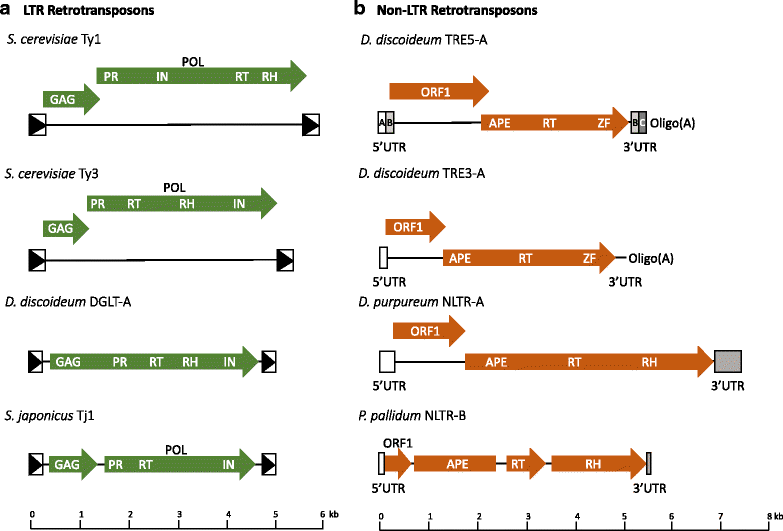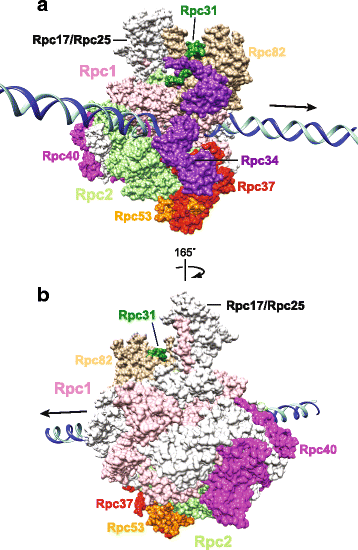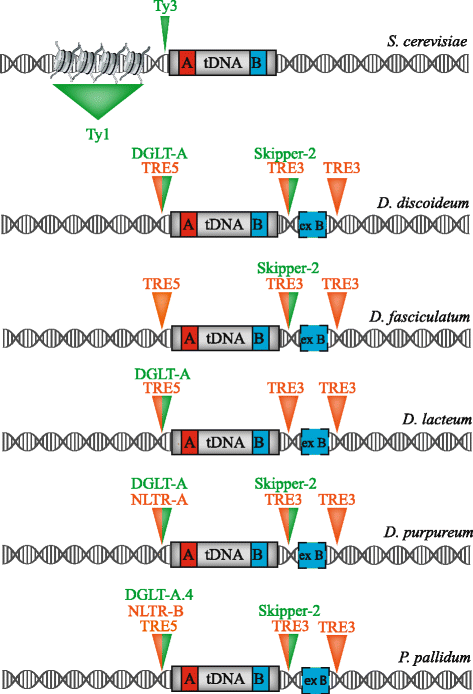Retrotransposon targeting to RNA polymerase III-transcribed genes
- PMID: 29713390
- PMCID: PMC5911963
- DOI: 10.1186/s13100-018-0119-2
Retrotransposon targeting to RNA polymerase III-transcribed genes
Abstract
Retrotransposons are genetic elements that are similar in structure and life cycle to retroviruses by replicating via an RNA intermediate and inserting into a host genome. The Saccharomyces cerevisiae (S. cerevisiae) Ty1-5 elements are long terminal repeat (LTR) retrotransposons that are members of the Ty1-copia (Pseudoviridae) or Ty3-gypsy (Metaviridae) families. Four of the five S. cerevisiae Ty elements are inserted into the genome upstream of RNA Polymerase (Pol) III-transcribed genes such as transfer RNA (tRNA) genes. This particular genomic locus provides a safe environment for Ty element insertion without disruption of the host genome and is a targeting strategy used by retrotransposons that insert into compact genomes of hosts such as S. cerevisiae and the social amoeba Dictyostelium. The mechanism by which Ty1 targeting is achieved has been recently solved due to the discovery of an interaction between Ty1 Integrase (IN) and RNA Pol III subunits. We describe the methods used to identify the Ty1-IN interaction with Pol III and the Ty1 targeting consequences if the interaction is perturbed. The details of Ty1 targeting are just beginning to emerge and many unexplored areas remain including consideration of the 3-dimensional shape of genome. We present a variety of other retrotransposon families that insert adjacent to Pol III-transcribed genes and the mechanism by which the host machinery has been hijacked to accomplish this targeting strategy. Finally, we discuss why retrotransposons selected Pol III-transcribed genes as a target during evolution and how retrotransposons have shaped genome architecture.
Keywords: Integrase; RNA polymerase III; Retrotransposon; S. cerevisiae; Ty element; tRNA.
Conflict of interest statement
Not applicable.The authors declare that they have no competing interests.Springer Nature remains neutral with regard to jurisdictional claims in published maps and institutional affiliations.
Figures



References
-
- Finnegan DJ. Eukaryotic transposable elements and genome evolution. Trends Genet. 1989;5(4):103–107. - PubMed
-
- Wicker T, Sabot F, Hua-Van A, Bennetzen JL, Capy P, Chalhoub B, Flavell A, Leroy P, Morgante M, Panaud O, et al. A unified classification system for eukaryotic transposable elements. Nat Rev Genet. 2007;8(12):973–982. - PubMed
-
- Boeke JD, Garfinkel DJ, Styles CA, Fink GR. Ty elements transpose through an RNA intermediate. Cell. 1985;40(3):491–500. - PubMed
-
- Lesage P, Todeschini AL. Happy together: the life and times of ty retrotransposons and their hosts. Cytogenet Genome Res. 2005;110(1–4):70–90. - PubMed
Publication types
LinkOut - more resources
Full Text Sources
Other Literature Sources
Molecular Biology Databases
Miscellaneous

